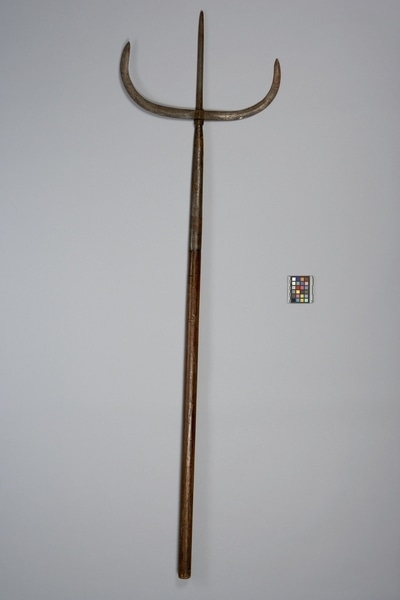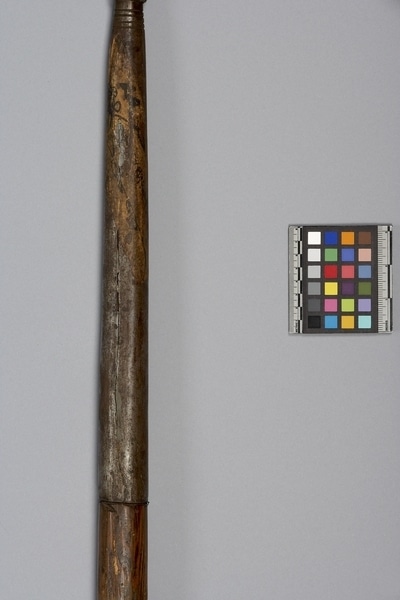Trident Spear Item Number: 1704/9 from the MOA: University of British Columbia


Description
Cantonese opera, long-handled trident. The shaft is made of a cylindrical-shaped piece of wood, which joins to a tapering metal shaft at the top of which is a straight, vertical metal spike with four sides, and a flat, crescent-shaped piece of metal with pointed ends.
History Of Use
This trident is both a weapon and ritual object. It evolved within agricultural communities in Guangdong, China. There’s a piece of paper with writing on it, glued to the top of the handle bar, near the spikes. The paper is “spirit writing” (fu ji), which was created by a Daoist ritual specialist who would go into a trance to summon a spirit to possess his body and do the writing. The paper would be used to expel evil (bi xie). It is not readable, and requires a specialist to interpret. It was likely attached to this object to enhance its ritual power to expel evil. Spirit writing was very popular in Guangdong during the late 19th and early 20th century. Cantonese opera troupes carried this object with them to perform a ritual called “breaking the stage” (po tai ), which is to purify a new mat-shed theatre stage before its maiden use. The practice died out after the Communists came to power in 1949, but may have persisted deep in the countryside until the late 1950s. Since this trident was brought to Canada by a Cantonese opera troupe, it is likely that the ritual was also performed in Canada.
Narrative
An oral account of the po tai ritual (by master Ieong Hoi-seng): “The opera troupe’s second painted face role (er hua mian) would have the job of performing this ritual, which is called po tai. He may do it alone or have the help of the other lesser martial characters. After putting on makeup and costume (kai lian), the main performer will take the trident and climb up on a ladder and thrust it towards the center of the ceiling of the mat-shed theatre (cao peng) with all his might. If he succeeded in piercing through the roof, it would be safe to perform at that site. If it did not pierce through, the entire troupe would pack up their things and leave. Before this takes place, the troupes cannot open any of their trunks. If the ritual is successful, the painted face role will take a piece of paper and press it to his face, so that his make-up leaves an imprint. He will then sell this paper in the marketplace and villagers will buy it to put on their home altars for the purpose of expelling evil from the home. I never saw the ritual myself, but I learned of it through my teachers who witnessed it. I also performed in the same mat-shed theatres where such a ritual took place and learned about it from the local people.” Donated as part of a collection of Cantonese opera props used by the Jin Wah Sing Musical Association.
Item History
- Made in China during 1890
- Owned by Jin Wah Sing Musical Association before October 15, 1996
- Received from Jin Wah Sing Musical Association (Donor) on October 15, 1996
What
Who
- Culture
- Chinese: Cantonese
- Previous Owner
- Jin Wah Sing Musical Association
- Received from
- Jin Wah Sing Musical Association (Donor)
Where
- Holding Institution
- MOA: University of British Columbia
- Made in
- China
When
- Creation Date
- during 1890
- Ownership Date
- before October 15, 1996
- Acquisition Date
- on October 15, 1996
Other
- Condition
- fair
- Current Location
- Case 85
- Accession Number
- 1704/0009